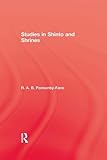Studies in Shinto and shrines / R.A.B Ponsonby-Fanee.
Material type: TextSeries: Kegan Paul Japan libraryPublisher: London : Kegan Paul, 2004Description: 1 online resource (iii, vi, 575 pages) : illustrationsContent type:
TextSeries: Kegan Paul Japan libraryPublisher: London : Kegan Paul, 2004Description: 1 online resource (iii, vi, 575 pages) : illustrationsContent type: - text
- computer
- online resource
- 9781136892943
- 113689294X
- 299.561 22
- BL2220 .P6 2004eb
- digitized 2011 HathiTrust Digital Library committed to preserve
| Item type | Home library | Collection | Call number | Materials specified | Status | Date due | Barcode | |
|---|---|---|---|---|---|---|---|---|
 Electronic-Books
Electronic-Books
|
OPJGU Sonepat- Campus | E-Books EBSCO | Available |
Includes bibliographical references and index.
Use copy Restrictions unspecified star MiAaHDL
Electronic reproduction. [Place of publication not identified] : HathiTrust Digital Library, 2011. MiAaHDL
Master and use copy. Digital master created according to Benchmark for Faithful Digital Reproductions of Monographs and Serials, Version 1. Digital Library Federation, December 2002. MiAaHDL
http://purl.oclc.org/DLF/benchrepro0212
digitized 2011 HathiTrust Digital Library committed to preserve pda MiAaHDL
Print version record.
Cover; Half Title; Title Page; Copyright Page; Preface; Table of Contents; I. The Imperial Family and Shinto; Introduction; The Shinto Theogony; The Sanshu-no-Shinki or Three Sacred Regalia (1); The Saikū and Saiin, or Imperial Princess Priestess in the Service of the Great Ise Inner Shrine; Apotheosis or the Japanese Way of making Deities-the Editor; The Introduction of Buddhism; The Jingi-kwan, or Office in charge of all Matters pertaining to the Worship of the Shinto Deities; Court Festivals; Ryōbu-Shinto, or the Assimilation of Shintoism and Buddhism (1).
The Naishidokoro, or Place where the Imperial Ancestress, Amaterasu Omikami, being waited upon by a Class of Women Attendants called the Naishi who took charge of the Mirror representing the Divine Spirit of the Sun-GoddessAramitama, or the Rough (Active) Spirit, in contradistinction to the Nigimitama, or Peaceful (passive) Spirit, of Shinto Deities; Ryōbu Shinto (2); The Saiin, or the Imperial Princess Priestess serving in the Kamo Shrines of the Province of Yamashiro.
The Saijo or Itsukime, the Priestess chosen from among the Fujiwara Daughters to serve Their Tutelary Deities (shrines) of Kasuga of Yamato and Oharano of YamashiroIwashimizu, a great Shinto Shrine erected on the hill Otokoyama near Kyoto in 859 inviting the Deities of Usa Hachiman Shrine of Tsukushi (now Kyūshū); The Sanshu-no-Shinki (2); Divination, used at the Imperial Court whenever the Will of the Gods i.e. the Imperial Ancestors is in doubt; Imperial Visits to Shrines; II Three Great Emperors; The Emperor Tenji; The Emperor Go-Sanjō; The Emperor Go-Toba; III. Yatagarasu.
Identification of YatagarasuKumano Saozan, or The Three Shrines in Kumano; Yatagarasu Ceremony; Ceremonies at other Kumano Shrines; IV. Yasoshima-No-Matsuri; Appendix, A Table giving the Dates of Despatch of Messengers and of Solemnisation of the Matsuri; V. Kwampei Taisha to Sono Gosaijin or the First Class Government Shrines and their Deities; VI. Kamo Gejō Ryōsha; The Foundation of the Shrines and the Deities Worshipped; The Origin and Purpose of the Aoi Matsuri; Kwansai, or the Official or Imperial Festival, and Kokusai, or Provincial Festival; Rinjisai, or occasional Festival.
Imperial Visits etc. Buildings; Court Honours; Priests; Bad Times; Special Honour; Aoi Matsuri Procession and Various Ceremonies; VII. Ōyamato Jinja (Shrine); History of the Deities and the Institution of Their Worship; Rank, Status and Possessions; Go-Shintai; Sessha; Priests; Festivals; VIII. Tatsuta Jinja (Shrine); Foundation and the Deities Worshipped; Buildings; Rank and Status; Festivals; Priests; Bekkū, Sessba and Massha; IX. Nibukawakami Jinja (Shrine); X. Hiraoka Jinja (Shrine); XI. Suminoe-No-Ōkami; History of the Deities and the Institution of Their Worship; Buildings; Priests.
First Published in 2005. Routledge is an imprint of Taylor & Francis, an informa company.
eBooks on EBSCOhost EBSCO eBook Subscription Academic Collection - Worldwide
There are no comments on this title.

